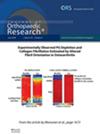Acute Prolonged Hamstrings Vibration Reduces Limb Stiffness Following Anterior Cruciate Ligament Reconstruction During a Single-Limb Drop-Jump Task
Abstract
Impaired quadriceps function influences lower limb biomechanics following anterior cruciate ligament reconstruction (ACLR). This often results in stiff limb loading which leads to the development of knee osteoarthritis. Greater hamstrings/quadriceps co-activation is common after ACLR and is, in part, responsible for impaired quadriceps function. Prolonged vibration of the hamstrings can alleviate reciprocal inhibition of the quadriceps and enhance quadriceps activation. We hypothesize that this will also reduce limb stiffness. Fourteen participants with unilateral ACLR, and 14 non-injured individuals performed a single-leg drop-landing task, before and after 20 min of hamstrings vibration. Limb stiffness, peak vertical ground reaction force, peak instantaneous loading rate, knee excursion, and peak knee extension moment were calculated during the loading phase of the drop-landing task. The ACLR group had significantly greater limb stiffness (p = 0.002), peak vertical ground reaction force (p = 0.004), loading rate (p = 0.001), significantly less knee excursion (p = 0.009) and knee extension moment (p = 0.013) before vibration than non-injured controls. Vibration significantly reduced limb stiffness (p = 0.001), peak vertical ground reaction force (p = 0.001), loading rate (p < 0.001), significantly increased knee excursion (p = 0.01) and knee extension moment (p < 0.001) in the ACLR group. No significant differences were found following vibration in the non-injured control group.
Clinical Significance
These results demonstrate that prolonged vibration of the hamstrings has the potential to mitigate the stiff limb loading strategy linked to knee osteoarthritis development, and may represent an effective adjunct therapy for ACLR rehabilitation.


 求助内容:
求助内容: 应助结果提醒方式:
应助结果提醒方式:


